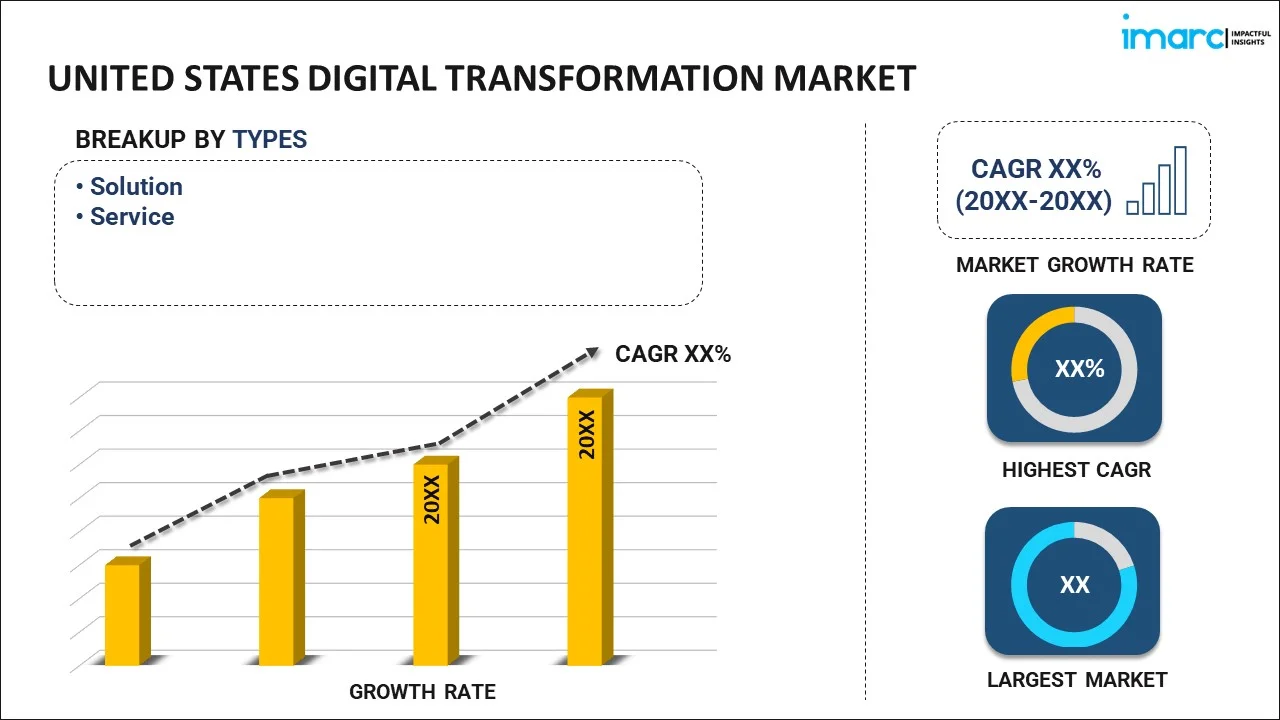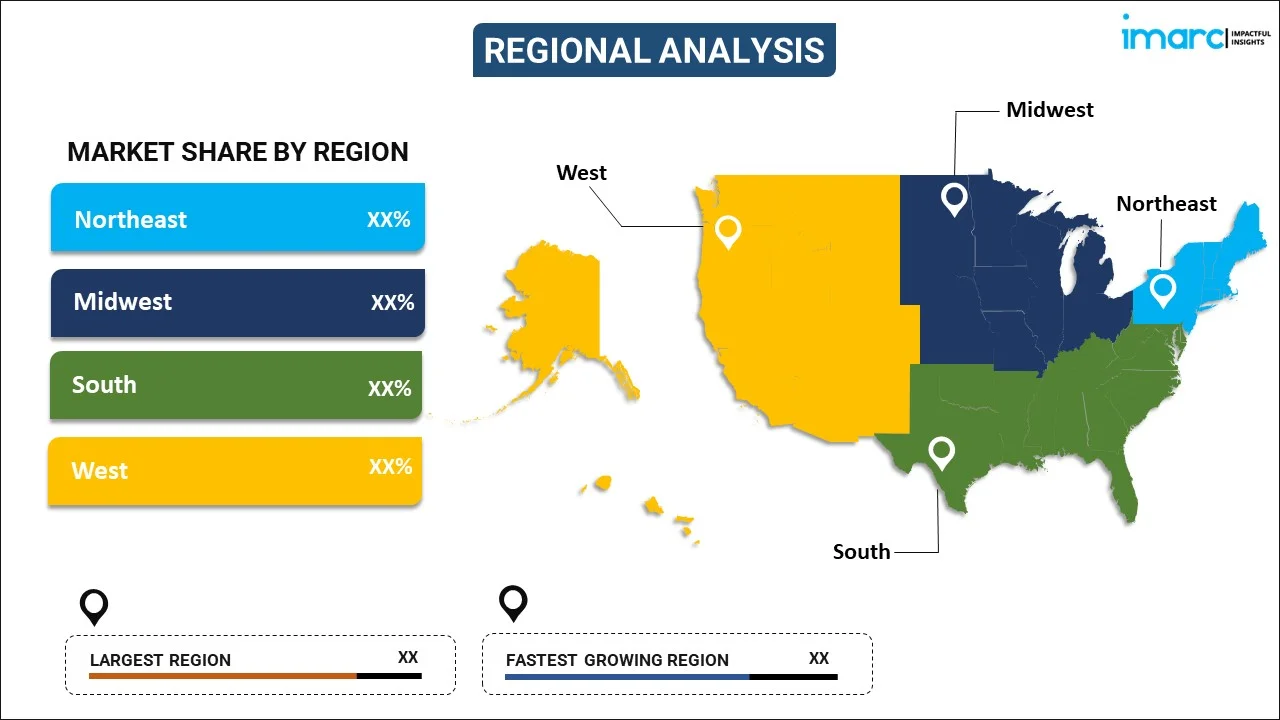
United States Digital Transformation Market Report by Type (Solution, Service), Deployment Mode (Cloud-based, On-premises), Enterprise Size (Large Enterprises, Small and Medium-sized Enterprises), End Use Industry (BFSI, Manufacturing and Retail, Government, Healthcare, IT and Telecom, and Others), and Region 2025-2033
Market Overview:
The United States digital transformation market size reached USD 210.4 Billion in 2024. Looking forward, IMARC Group expects the market to reach USD 1,375.5 Billion by 2033, exhibiting a growth rate (CAGR) of 21.6% during 2025-2033. The growing adoption of remote and flexible work practices in organizations, rising demand for seamless and intuitive digital experiences among individuals, and the increasing emphasis on data-driven decision-making in different businesses represent some of the key factors driving the market.
|
Report Attribute
|
Key Statistics
|
|---|---|
|
Base Year
|
2024
|
|
Forecast Years
|
2025-2033
|
|
Historical Years
|
2019-2024
|
|
Market Size in 2024
|
USD 210.4 Billion |
|
Market Forecast in 2033
|
USD 1,375.5 Billion |
| Market Growth Rate 2025-2033 | 21.6% |
Digital transformation refers to the comprehensive integration of digital technologies into various aspects of operations, strategies, and processes of organizations to drive fundamental changes in business operations and deliver values. It encompasses technological advancements and cultural adjustments, aiming to enhance efficiency, customer experience, and overall competitiveness. It also involves adopting and leveraging technologies, such as cloud computing, artificial intelligence (AI), data analytics, and the Internet of Things (IoT), to streamline operations, optimize decision-making, and create innovative products and services. It enables companies to collect and analyze vast amounts of data to gain insights into customer behaviors, market trends, and operational efficiencies. This data-driven approach empowers organizations to make informed decisions and tailor offerings to meet ever-changing customer expectations. Furthermore, digital transformation assists in reshaping organizational structures and fostering a culture of innovation that can encourage collaboration and provide employees with the tools and skills to adapt to new technologies. This cultural shift is essential to ensure that digital transformation efforts are sustainable and yield lasting benefits. Moreover, as it can lead to increased agility and improved customer engagement, cost savings, and competitive advantage, the demand for digital transformation is rising in the United States.
United States Digital Transformation Market Trends:
At present, technological advancements in various organizations, such as cloud computing, data analytics, artificial intelligence (AI), and the Internet of Things (IoT), represent one of the key factors supporting the growth of the market in the United States. These technologies enhance operational efficiency, foster innovation, and enable personalized customer experiences. Besides this, the rising demand for seamless and intuitive digital experiences across all touchpoints among individuals is propelling the growth of the market in the country. In addition, businesses are adopting digital strategies that cater to evolving customer expectations, driving them to embrace technologies that enable personalized engagement and convenience. Moreover, the growing trend of remote and flexible work practices in different organizations across the country is compelling companies to invest in remote collaboration, cybersecurity, and digital communication tools, which is positively influencing the market. Apart from this, governing agencies in the country are undertaking initiatives that promote digital infrastructure development, data privacy regulations, and cybersecurity frameworks, which is contributing to the growth of the market. Additionally, industries in the US are becoming more saturated that is encouraging businesses to differentiate themselves by offering unique digital experiences and services. In line with this, the wide availability of data, along with the growing emphasis on data-driven decision-making, is offering a favorable market outlook in the country. Furthermore, the increasing demand for digital transformation, as it helps businesses to gather insights from vast amounts of data for making informed choices, optimize operations, and predict market trends, is bolstering the growth of the market.
United States Digital Transformation Market Segmentation:
IMARC Group provides an analysis of the key trends in each segment of the United States digital transformation market report, along with forecasts at the country level for 2025-2033. Our report has categorized the market based on type, deployment mode, enterprise size, and end use industry.
Type Insights:

- Solution
- Analytics
- Cloud Computing
- Mobility
- Social Media
- Others
- Service
- Professional Services
- Integration and Implementation
The report has provided a detailed breakup and analysis of the market based on the type. This includes solution (analytics, cloud computing, mobility, social media, and others) and service (professional services and integration and implementation).
Deployment Mode Insights:
- Cloud-based
- On-premises
A detailed breakup and analysis of the market based on the deployment mode has also been provided in the report. This includes cloud-based and on-premises.
Enterprise Size Insights:
- Large Enterprises
- Small and Medium-sized Enterprises
A detailed breakup and analysis of the market based on the enterprise size has also been provided in the report. This includes large enterprises and small and medium-sized enterprises.
End Use Industry Insights:
- BFSI
- Manufacturing and Retail
- Government
- Healthcare
- IT and Telecom
- Others
A detailed breakup and analysis of the market based on the end use industry has also been provided in the report. This includes BFSI, manufacturing and retail, government, healthcare, IT and telecom, and others.
Regional Insights:

- Northeast
- Midwest
- South
- West
The report has also provided a comprehensive analysis of all the major regional markets, which include Northeast, Midwest, South, and West.
Competitive Landscape:
The report has also provided a comprehensive analysis of the competitive landscape in the United States digital transformation market. Competitive analysis such as market structure, key player positioning, top winning strategies, competitive dashboard, and company evaluation quadrant has been covered in the report. Also, detailed profiles of all major companies have been provided.
United States Digital Transformation Report Coverage:
| Report Features | Details |
|---|---|
| Base Year of the Analysis | 2024 |
| Historical Period | 2019-2024 |
| Forecast Period | 2025-2033 |
| Units | Billion USD |
| Scope of the Report | Exploration of Historical and Forecast Trends, Industry Catalysts and Challenges, Segment-Wise Historical and Predictive Market Assessment:
|
| Types Covered |
|
| Deployment Modes Covered | Cloud-Based, On-Premises |
| Enterprise Sizes Covered | Large Enterprises, Small and Medium-Sized Enterprises |
| End Use Industries Covered | BFSI, Manufacturing and Retail, Government, Healthcare, IT And Telecom, Others |
| Regions Covered | Northeast, Midwest, South, and West |
| Customization Scope | 10% Free Customization |
| Post-Sale Analyst Support | 10-12 Weeks |
| Delivery Format | PDF and Excel through Email (We can also provide the editable version of the report in PPT/Word format on special request) |
Key Questions Answered in This Report:
- How has the United States digital transformation market performed so far and how will it perform in the coming years?
- What has been the impact of COVID-19 on the United States digital transformation market?
- What is the breakup of the United States digital transformation market on the basis of type?
- What is the breakup of the United States digital transformation market on the basis of deployment mode?
- What is the breakup of the United States digital transformation market on the basis of enterprise size?
- What is the breakup of the United States digital transformation market on the basis of end use industry?
- What are the various stages in the value chain of the United States digital transformation market?
- What are the key driving factors and challenges in the United States digital transformation market?
- What is the structure of the United States digital transformation market and who are the key players?
- What is the degree of competition in the United States digital transformation market?
Key Benefits for Stakeholders:
- IMARC’s report offers a comprehensive quantitative analysis of various market segments, historical and current market trends, market forecasts, and dynamics of the United States digital transformation market from 2019-2033.
- The research study provides the latest information on the market drivers, challenges, and opportunities in the United States digital transformation market.
- Porter's five forces analysis assist stakeholders in assessing the impact of new entrants, competitive rivalry, supplier power, buyer power, and the threat of substitution. It helps stakeholders to analyze the level of competition within the United States digital transformation industry and its attractiveness.
- Competitive landscape allows stakeholders to understand their competitive environment and provides an insight into the current positions of key players in the market.
Need more help?
- Speak to our experienced analysts for insights on the current market scenarios.
- Include additional segments and countries to customize the report as per your requirement.
- Gain an unparalleled competitive advantage in your domain by understanding how to utilize the report and positively impacting your operations and revenue.
- For further assistance, please connect with our analysts.
 Inquire Before Buying
Inquire Before Buying
 Speak to an Analyst
Speak to an Analyst
 Request Brochure
Request Brochure
 Request Customization
Request Customization




.webp)




.webp)












